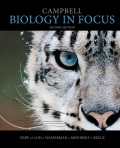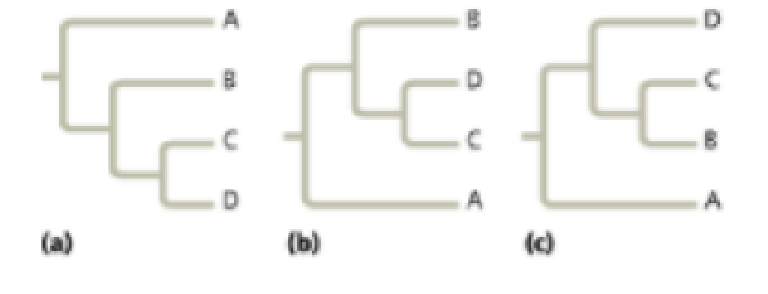
EBK CAMPBELL BIOLOGY IN FOCUS
2nd Edition
ISBN: 8220101459299
Author: Reece
Publisher: PEARSON
expand_more
expand_more
format_list_bulleted
Concept explainers
Textbook Question
Chapter 20.1, Problem 2CC
Which of the trees shown here depicts an evolutionary history different from the other two? Explain.

Expert Solution & Answer
Want to see the full answer?
Check out a sample textbook solution
Students have asked these similar questions
Answer this as a dental assistant student
buatkan judul skripsi tentang parasitologi yang sedang trendinh
Dental assistant
Chapter 20 Solutions
EBK CAMPBELL BIOLOGY IN FOCUS
Ch. 20.1 - Which levels of the classification in Figure 20.3...Ch. 20.1 - Which of the trees shown here depicts an...Ch. 20.1 - Prob. 3CCCh. 20.2 - Decide whether each of the following pairs of...Ch. 20.2 - WHAT IF? Suppose that two species, A and B, have...Ch. 20.3 - Prob. 1CCCh. 20.3 - The most parsimonious tree of evolutionary...Ch. 20.3 - WHAT IF? Draw a phylogenetic tree that includes...Ch. 20.4 - What is a molecular clock? What assumption...Ch. 20.4 - MAKE CONNECTIONS Review Concept 14.5. Then...
Ch. 20.4 - WHAT IF? Suppose a molecular clock dates the...Ch. 20.5 - Why is the kingdom Monera no longer considered a...Ch. 20.5 - Prob. 2CCCh. 20.5 - Prob. 3CCCh. 20 - In a comparison of birds and mammals, the...Ch. 20 - To apply parsimony to constructing a phylogenetic...Ch. 20 - Prob. 4TYUCh. 20 - Prob. 5TYUCh. 20 - If you were using cladistics to build a...Ch. 20 - Prob. 7TYUCh. 20 - SCIENTIFIC INQUIRY DRAW IT (a) Draw a phylogenetic...Ch. 20 - FOCUS ON EVOLUTION Darwin suggested looking at a...Ch. 20 - Prob. 10TYUCh. 20 - SYNTHESIZE YOUR KNOWLEDGE This West Indian manatee...
Additional Science Textbook Solutions
Find more solutions based on key concepts
Single penny tossed 20 times and counting heads and tails: Probability (prediction): _______/20 heads ________/...
Laboratory Manual For Human Anatomy & Physiology
The active ingredient in Tylenol and a host of other over-the-counter pain relievers is acetaminophen (C8H9NO2)...
Chemistry: Atoms First
Why do scientists think that all forms of life on earth have a common origin?
Genetics: From Genes to Genomes
Gregor Mendel never saw a gene, yet he concluded that some inherited factors were responsible for the patterns ...
Campbell Essential Biology (7th Edition)
To test your knowledge, discuss the following topics with a study partner or in writing ideally from memory. Th...
HUMAN ANATOMY
An obese 55-year-old woman consults her physician about minor chest pains during exercise. Explain the physicia...
Biology: Life on Earth with Physiology (11th Edition)
Knowledge Booster
Learn more about
Need a deep-dive on the concept behind this application? Look no further. Learn more about this topic, biology and related others by exploring similar questions and additional content below.Similar questions
- O Macmillan Learning Glu-His-Trp-Ser-Gly-Leu-Arg-Pro-Gly The pKa values for the peptide's side chains, terminal amino groups, and carboxyl groups are provided in the table. Amino acid Amino pKa Carboxyl pKa Side-chain pKa glutamate 9.60 2.34 histidine 9.17 1.82 4.25 6.00 tryptophan 9.39 2.38 serine 9.15 2.21 glycine 9.60 2.34 leucine 9.60 2.36 arginine 9.04 2.17 12.48 proline 10.96 1.99 Calculate the net charge of the molecule at pH 3. net charge at pH 3: Calculate the net charge of the molecule at pH 8. net charge at pH 8: Calculate the net charge of the molecule at pH 11. net charge at pH 11: Estimate the isoelectric point (pl) for this peptide. pl:arrow_forwardBiology Questionarrow_forwardThis entire structure (Pinus pollen cone) using lifecycle terminology is called what?arrow_forward
- This entire structure using lifecycle terminology is called what? megastrobilus microstrobilus megasporophyll microsporophyll microsporangium megasporangium none of thesearrow_forwardHow much protein should Sarah add to her diet if she gets pregnant? Sarah's protein requirements during pregnancy would be higher. See Hint B2. During calculations, use numbers rounded to the first decimal place. In your answer, round the number of grams to the nearest whole number. _______ g ?arrow_forwardC MasteringHealth MasteringNu X session.healthandnutrition-mastering.pearson.com/myct/itemView?assignment ProblemID=17396422&attemptNo=1&offset=prevarrow_forwardMost people, even those who exercise regularly at low to average intensity (1 hour at the gym or a 2- to 3-mile walk several times per week), do not need an increased protein intake. What would be the protein needs of a man named Josh who exercises moderately and is the same age and size as Wayne? Josh is 5 ft, 8 in tall and weighs 183 lb. Round the number of grams to the nearest whole number. During calculations, use numbers rounded to the first decimal place. Because protein requirement is a range, please enter two numbers: lower and upper range values, respectively. Separate the lower and upper range values, in that order, by a comma. ___, ___ g ?arrow_forwardC MasteringHealth MasteringNu X session.healthandnutrition-mastering.pearson.com/myct/itemView?assignment ProblemID=17396422&attemptNo=1&offset=prevarrow_forwardIf left untreated, most HIV-infected individuals will develop AIDS. Current treatments are focused on highlyactive antiretroviral therapy (HAART). HAART usually consists of an orally delivered drug cocktail containingtwo different reverse transcriptase inhibitors and one other drug, such as a protease inhibitor. Question: Develop a pharmacokinetic model of HAART treatment. Consider all 3 drugs. Make sure to include adiagram that illustrates your thinking, state all assumptions, and define your variables. Whatparameters would you need to know to find the concentration of drug in the plasma? In the T cells?(You do not need to write out or solve any equations.)arrow_forwardnot use ai pleseaarrow_forward(A) 25 20 20 15 NPP (Mg C/ha/yr) 10 10 5 0 0 2,000 4,000 6,000 ECOLOGY 4e, Figure 20.11 (Part 1) 2017 Sinauer Associates, Inc. Average annual precipitation (mm) 8,000arrow_forwardexplain the cascade of events (starting with relaxing trade winds) that occurs during El Niño in the eastern Pacific (off the coasts of California/North America and Peru/South America) and which lead to food-chain collapse - start with changes in the physical/oceanographic conditions, andthen systematically describe the cascading effects at each level of the food chain -arrow_forwardarrow_back_iosSEE MORE QUESTIONSarrow_forward_iosRecommended textbooks for you
 Biology: The Dynamic Science (MindTap Course List)BiologyISBN:9781305389892Author:Peter J. Russell, Paul E. Hertz, Beverly McMillanPublisher:Cengage Learning
Biology: The Dynamic Science (MindTap Course List)BiologyISBN:9781305389892Author:Peter J. Russell, Paul E. Hertz, Beverly McMillanPublisher:Cengage Learning Concepts of BiologyBiologyISBN:9781938168116Author:Samantha Fowler, Rebecca Roush, James WisePublisher:OpenStax College
Concepts of BiologyBiologyISBN:9781938168116Author:Samantha Fowler, Rebecca Roush, James WisePublisher:OpenStax College Biology Today and Tomorrow without Physiology (Mi...BiologyISBN:9781305117396Author:Cecie Starr, Christine Evers, Lisa StarrPublisher:Cengage Learning
Biology Today and Tomorrow without Physiology (Mi...BiologyISBN:9781305117396Author:Cecie Starr, Christine Evers, Lisa StarrPublisher:Cengage Learning
 Biology (MindTap Course List)BiologyISBN:9781337392938Author:Eldra Solomon, Charles Martin, Diana W. Martin, Linda R. BergPublisher:Cengage Learning
Biology (MindTap Course List)BiologyISBN:9781337392938Author:Eldra Solomon, Charles Martin, Diana W. Martin, Linda R. BergPublisher:Cengage Learning
 Biology: The Dynamic Science (MindTap Course List)BiologyISBN:9781305389892Author:Peter J. Russell, Paul E. Hertz, Beverly McMillanPublisher:Cengage Learning
Biology: The Dynamic Science (MindTap Course List)BiologyISBN:9781305389892Author:Peter J. Russell, Paul E. Hertz, Beverly McMillanPublisher:Cengage Learning Concepts of BiologyBiologyISBN:9781938168116Author:Samantha Fowler, Rebecca Roush, James WisePublisher:OpenStax College
Concepts of BiologyBiologyISBN:9781938168116Author:Samantha Fowler, Rebecca Roush, James WisePublisher:OpenStax College Biology Today and Tomorrow without Physiology (Mi...BiologyISBN:9781305117396Author:Cecie Starr, Christine Evers, Lisa StarrPublisher:Cengage Learning
Biology Today and Tomorrow without Physiology (Mi...BiologyISBN:9781305117396Author:Cecie Starr, Christine Evers, Lisa StarrPublisher:Cengage Learning
 Biology (MindTap Course List)BiologyISBN:9781337392938Author:Eldra Solomon, Charles Martin, Diana W. Martin, Linda R. BergPublisher:Cengage Learning
Biology (MindTap Course List)BiologyISBN:9781337392938Author:Eldra Solomon, Charles Martin, Diana W. Martin, Linda R. BergPublisher:Cengage Learning
Mechanisms of Genetic Change or Evolution; Author: Scientist Cindy;https://www.youtube.com/watch?v=5FE8WvGzS4Q;License: Standard Youtube License
